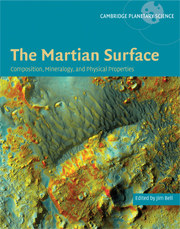Book contents
- Frontmatter
- Contents
- List of contributors
- Foreword
- Acknowledgments
- Part I Introduction and historical perspective
- Part II Elemental Composition: Orbital and in situ Surface Measurements
- Part III Mineralogy and Remote Sensing of Rocks, Soil, Dust, and Ices
- Part IV Physical Properties of Surface Materials
- Part V Synthesis
- 22 Implications of observed primary lithologies
- 23 Aqueous alteration on Mars
- 24 The sedimentary rock cycle of Mars
- 25 Martian polar processes
- 26 Astrobiological implications of Mars' surface composition and properties
- Part VI Summary, Upcoming Missions, and New Measurement Needs
- Index
- Plate section
- References
25 - Martian polar processes
from Part V - Synthesis
Published online by Cambridge University Press: 10 December 2009
- Frontmatter
- Contents
- List of contributors
- Foreword
- Acknowledgments
- Part I Introduction and historical perspective
- Part II Elemental Composition: Orbital and in situ Surface Measurements
- Part III Mineralogy and Remote Sensing of Rocks, Soil, Dust, and Ices
- Part IV Physical Properties of Surface Materials
- Part V Synthesis
- 22 Implications of observed primary lithologies
- 23 Aqueous alteration on Mars
- 24 The sedimentary rock cycle of Mars
- 25 Martian polar processes
- 26 Astrobiological implications of Mars' surface composition and properties
- Part VI Summary, Upcoming Missions, and New Measurement Needs
- Index
- Plate section
- References
Summary
ABSTRACT
The polar caps are the most active regions on Mars. The annual cycling of atmospheric CO2 into the seasonal CO2 ice caps is a driving force of the Martian climate. The polar layered deposits (PLDs), with thousands of layers whose thickness is only resolvable with sub-meter spatial resolution from orbit, may contain a record of past climates. The polar regions contain the majority of known H2O ice deposits, distributed between the residual caps and near-surface ice in the regolith. In this chapter, we synthesize results from missions and instruments largely presented in detail elsewhere in this book, and consider the implications for Martian polar processes and the areas for future research. The focus here is on presenting evidence for and interpretations concerning the CO2 cycle and other related polar processes. Implications for water-ice in the subsurface are examined with respect to its effects on the CO2 cycle. Comparisons of water-ice abundance to the mass and distribution of seasonal CO2 ice are also explored. While the amount of available data has increased exponentially, our knowledge and understanding of Martian polar processes has increased much more gradually. As each question about the polar regions of Mars is answered, several new questions are brought to light. Many of the processes that occur in the polar regions of Mars do not have direct analogs on Earth, but do have analogs in other parts of the Solar System.
- Type
- Chapter
- Information
- The Martian SurfaceComposition, Mineralogy and Physical Properties, pp. 578 - 598Publisher: Cambridge University PressPrint publication year: 2008
References
- 14
- Cited by

